 Miscellaneous
Miscellaneous  Miscellaneous
Miscellaneous  Our World
Our World 10 Green Practices That Actually Make a Difference
 Humans
Humans Ten Historic Men Who Deserve Way More Credit Than They Got
 Movies and TV
Movies and TV The 10 Most Heartwarming Moments in Pixar Films
 Travel
Travel Top 10 Religious Architectural Marvels
 Creepy
Creepy 10 Haunted Places in Alabama
 History
History Top 10 Tragic Facts about England’s 9 Days Queen
 Food
Food 10 Weird Foods Inspired by Your Favorite Movies
 Religion
Religion 10 Mind-Blowing Claims and Messages Hidden in the Bible Code
 Facts
Facts 10 Things You Never Knew about the History of Gambling
 Miscellaneous
Miscellaneous Ten Groundbreaking Tattoos with Fascinating Backstories
 Our World
Our World 10 Green Practices That Actually Make a Difference
 Humans
Humans Ten Historic Men Who Deserve Way More Credit Than They Got
Who's Behind Listverse?

Jamie Frater
Head Editor
Jamie founded Listverse due to an insatiable desire to share fascinating, obscure, and bizarre facts. He has been a guest speaker on numerous national radio and television stations and is a five time published author.
More About Us Movies and TV
Movies and TV The 10 Most Heartwarming Moments in Pixar Films
 Travel
Travel Top 10 Religious Architectural Marvels
 Creepy
Creepy 10 Haunted Places in Alabama
 History
History Top 10 Tragic Facts about England’s 9 Days Queen
 Food
Food 10 Weird Foods Inspired by Your Favorite Movies
 Religion
Religion 10 Mind-Blowing Claims and Messages Hidden in the Bible Code
 Facts
Facts 10 Things You Never Knew about the History of Gambling
10 Extraordinary Fires With Unexpected Consequences
Fire has set humans apart from the animal kingdom and allowed us to rise to greatness. However, fire is also something that we must handle with extraordinary care. The flames of the past have caused massive destruction, but that destruction sometimes allowed us to take great strides forward as well.
10 Great Salem Fire
1914
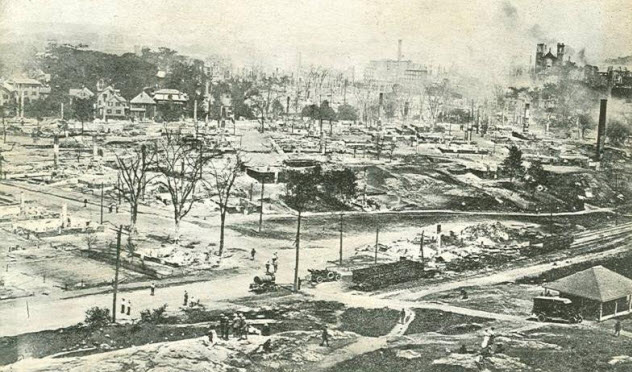
In summer 1914, approximately 18,000 people—nearly one-half the residents of Salem, Massachusetts—found themselves homeless. On the afternoon of June 25, a fire started in “Blubber Hollow,” an area in the leather manufacturing district unprotected by fire prevention sprinkler systems. Over the next 13 hours, the fire raged, consuming a swath of land 1 kilometer (0.5 mi) wide and 2 kilometers (1 mi) long. Over 250 acres and 1,750 buildings were in ruin, which was nearly one-third of the city.
With so many homeless, something had to be done quickly. The main factors contributing to the blaze had been buildings constructed tightly together and wooden building materials creating fuel for the flames. By July 8, the Salem Building Commission had been created. A new building code was approved by August 20. The city of Salem also enlarged their fire department, and new water sources were created to fight future infernos.
New construction primarily consisted of brick-and-stone structures, with consideration given to more open space between buildings. By July 1917, only three years after the devastation, nearly 1,000 new buildings had been completed, providing housing for the displaced families. The advisory architect for the city noted that there was less overcrowding and that the new buildings had a much greater value than those destroyed by the fire.
9 Great Chicago Fire
1871
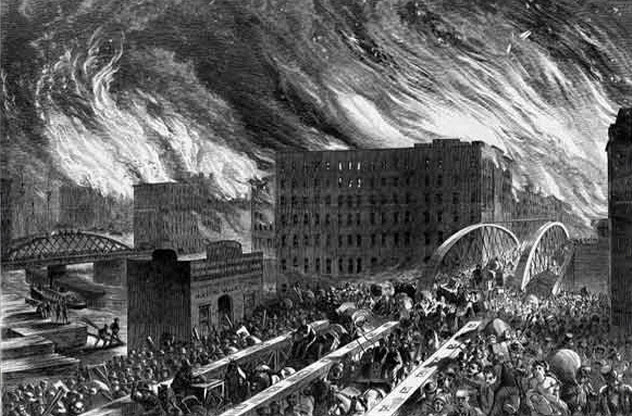
Although many of us are familiar with the infamous tale of the O’Leary cow kicking over a lantern and causing the greatest fire in Chicago’s history, we may not know much about the aftermath of this conflagration.
In the 100 days leading up to October 10, 1871, Chicago had seen barely more than 3 centimeters (1 in) of rainfall. Combined with high summer temperatures, the lack of rain had left the city extremely dry. Unfortunately, most structures were built of wood, creating a tinderbox ready to ignite.
Undoubtedly, the blaze originated in or near the O’Leary barn, although it is unlikely to have been of bovine origin. The fire sparked on October 8 and raged until October 10, causing widespread destruction of downtown Chicago. The fire spared few victims, leaving a path of destruction 6 kilometers (4 mi) long and 2 kilometers (1 mi) wide. Approximately 17,000 structures were destroyed in the heart of the city, leaving nearly 100,000 people homeless and causing an estimated $200 million in damages.
The rubble and ruins, along with thousands of displaced citizens, led to lawlessness and looting. Martial law was imposed on October 11 and lasted several weeks. In true American fashion, businesses quickly sprang up to help clean up and rebuild the ruined city. Luckily, Chicago’s transportation system had remained largely undamaged, and materials were soon transported to help with the reconstruction efforts.
The removal of downtown Chicago’s wooden structures cleared the way for a handful of architects to lay a modern foundation for the city, including the construction of the world’s first “skyscraper.” This rising from the ashes would cement Chicago as one of the country’s great cities, boosting the population from 324,000 in 1871 to over 1 million by 1890.
Ironically, the current Chicago Fire Department has located its training academy on the site of the initial blaze, the original O’Leary property.
8 The Burning Of Rome
AD 64
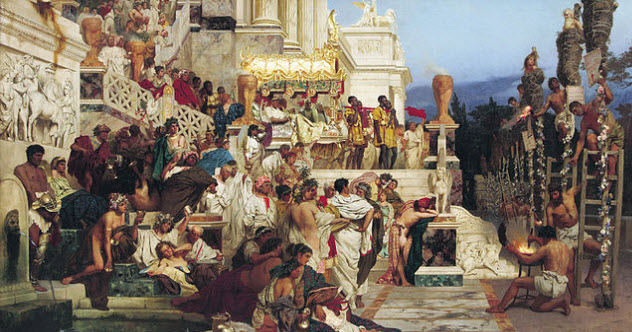
For many of us, the burning of Rome brings visions of Nero dancing in the flames and infamously playing his fiddle. As this blaze occurred nearly 2,000 years ago, we may never know the exact details that sparked this destructive event. But we do know what happened in the aftermath of the smoldering ruins—some things positive and some quite the opposite.
While rumors abound that Nero was responsible for setting Rome ablaze, he was actually residing in his palace in Antium when the flames started on July 18 in AD 64. By all accounts, when Nero discovered that Rome was on fire, he rushed back to his city of two million people and helped them by directing firefighting brigades and opening private and public places to the masses as areas of refuge.
Even so, the flames—fueled by a city constructed mostly of wooden structures—burned for six days and seven nights. Of the 14 districts of Rome, only four remained intact. Many significant buildings were destroyed, including the 800-year-old Temple of Jupiter Stator.
The aftereffects of the fire were numerous. On the positive side, the vast, overcrowded “slum” sections of the city were rebuilt with more fireproof materials and more common areas for the citizens. The once mostly wooden city rose from the ashes, rebuilt in magnificent marble with wide pedestrian streets and spectacular public works.
Nero also took advantage of the newly available real estate to create a series of villas and palaces within the city that were situated on a newly created park and man-made lake. The opulence of these palaces and the cost of construction eventually led to civil unrest and his ousting a few years later.
The most unfortunate outcome of the burning of Rome landed solidly on a rather obscure religious sect. With many believing that Nero was responsible for the destruction, he needed someone else to blame. He pointed the finger at a small religious sect in the city known as Christians. Nero fed them to the lions in the city’s amphitheaters. He also crucified them and burned them as torches in his newly constructed villas.
7 Great Fire Of London
1666
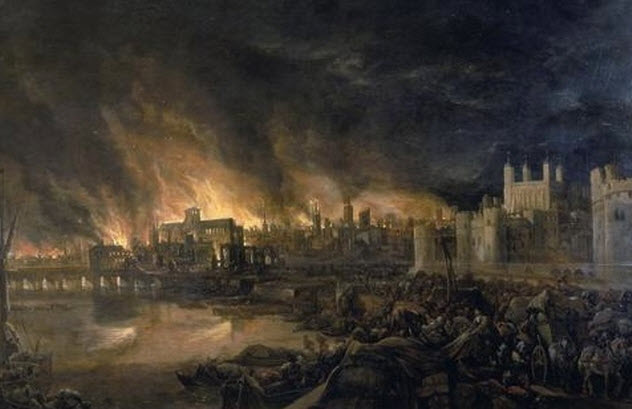
London has burned many times in its long, storied history. However, the fire of 1666 was the most devastating for the City of London, the section located inside the old Roman city wall. More than 13,000 homes were destroyed, along with 89 churches and 52 guild halls. All told, around 430 acres were razed, almost 80 percent of the city proper, leaving around 70,000 of the City of London’s 80,000 residents homeless.
The fire erupted on the night of September 2, 1666, in the bakeshop of Thomas Faynor, a baker for King Charles II. An oven was improperly extinguished, and the heat sparked the fire. At the time, construction consisted of an extremely flammable combination of wood and pitch. The flames soon leaped from the baking district to the riverside wharves and warehouses, which contained timber, hemp, oil, and coal. This fueled the raging inferno, allowing it to burn unchecked for another three days.
Unbelievably, only about 16 human lives were lost in the great fire. One hugely positive impact of the flames was the decimation of the rat population in the city. The plague had been ravishing London since 1665, and the fire wiped out an enormous percentage of the disease-carrying rodents, greatly reducing the spread of the plague.
In the aftermath of the destruction, Charles II appointed renowned architect Sir Christopher Wren and a board of commissioners to redesign the city and construct the now famous St. Paul’s Cathedral. By 1671, 9,000 new buildings had been completed with sturdier construction and wider city streets.
6 Great Baltimore Fire
1904
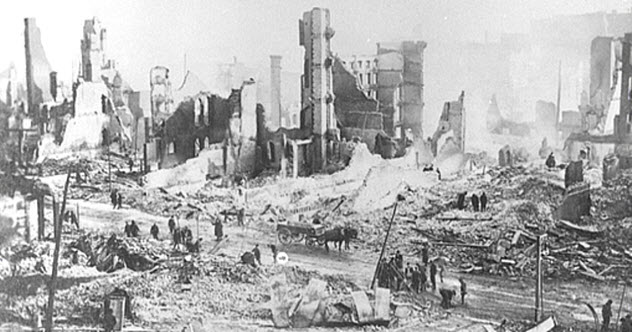
The Great Baltimore Fire of 1904 may not seem significant to most of us, but it was instrumental in standardizing US firefighting equipment. It’s suspected that the fire started with a stray cigar or cigarette on the evening of February 7, creating a small fire in the Hurst Building in the business district of Baltimore. The flames spread quickly through the mostly deserted business district before a call arose for local firefighters to respond.
The conflagration became so widespread that calls for help were dispatched to Washington, DC, Philadelphia, and even New York City. The fire eventually covered an 80-block area of downtown. However, when the fire brigades of the neighboring cities arrived, they could offer little help because their equipment wasn’t compatible with the fire hydrants and hoses of Baltimore.
Ultimately, the fire raged for over 31 hours with more than 1,500 buildings of downtown Baltimore destroyed and another 1,000 damaged. The estimated losses amounted to more than $150 million. Luckily, the blaze was confined to the downtown business district, so no lives or residential homes were lost.
The media attention caused by the fire provoked a nationwide outcry against the lack of national standards governing firefighting equipment and codes. This criticism led to the adoption of national sizes for fire hydrant and hose connections.
5 Peshtigo Fire
1871
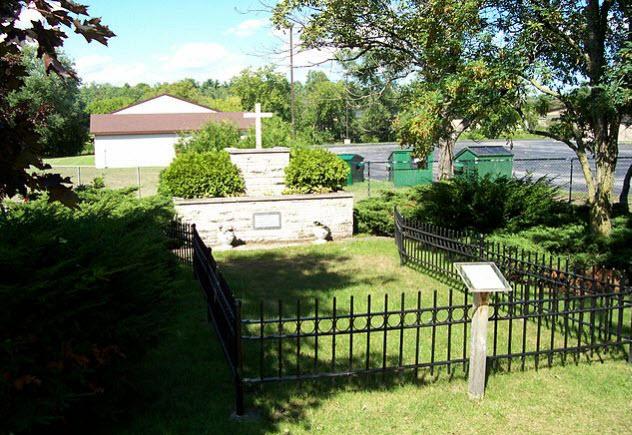
At the same time as the Great Chicago Fire on October 8, 1871, another blaze was raging through Wisconsin and the Upper Peninsula of Michigan that was more widespread and deadly but is often overlooked. The Peshtigo Fire, also known as the “forgotten fire,” was the worst forest fire the US has ever recorded.
As mentioned earlier, the 100 days leading up to October 8 had high temperatures and a prolonged drought, causing the forests of Wisconsin to become a mass of tinder ready to catch fire at the slightest spark.
We don’t know what caused that initial spark, but the forest fires in Wisconsin soon became full-fledged firestorms. A firestorm is an incredibly strong fire that creates its own wind systems, with tornado-like walls, cyclones of fire, and winds up to 180 kilometers per hour (110 mph). These firestorms were soon raging through the forests, towns, and cities of Wisconsin and Upper Michigan.
An estimated 1.2 million acres of land were burned throughout the two states, and about 1,200–2,500 people died. The exact number was not able to be determined because the total loss of life and records in some communities meant that there was no one left alive to identify the dead.
Years later, the knowledge of these fires was used to cause more death and destruction. During World War II, Great Britain and the US were planning bombing raids across Europe and closely studied the combination of conditions (wind, topography, and ignition sources) to artificially recreate the firestorms that had devastated the Midwest in 1871.
4 Great Seattle Fire
1889
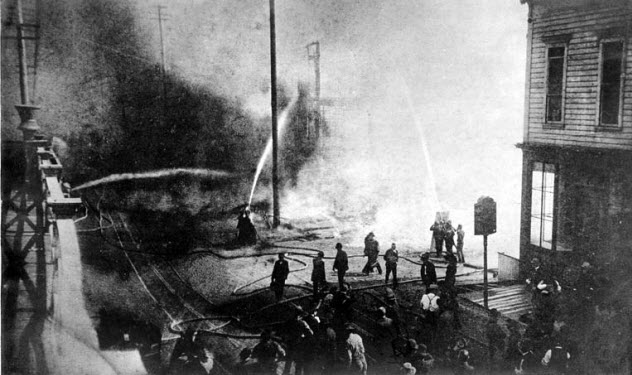
Until 1889, Seattle was little more than a lumber depot in the Northwest that supplied goods to the coast of California. Nearly every building in Seattle was constructed of wood, the most readily available and cheapest material. But this also made Seattle a prime target for a citywide conflagration.
On June 6, 1889, a tradesman in a woodworking shop was heating a ball of glue when it burst into flames. The fire spread quickly across the sawdust strewn on the floor and engulfed the entire building. The blaze soon jumped to the neighboring liquor store and several saloons. Fueled by large amounts of alcohol and combustible timber, the fire soon overtook the wharves and docks and began moving downtown. Eventually, it destroyed 25 city blocks and 125 acres of the town.
With the quick spread of the blaze, firefighters had a hard time containing the flames. However, the speed of the fire wasn’t their only obstacle. The water supply to fight fires was vastly inadequate, and nearly all of the “piping” used to deliver water was constructed of hollowed-out logs, which were also burning. Water pressures dropped, and the hoses were no longer spraying water. Although the fire eventually burned itself out, estimated losses reached a staggering $20 million.
After the fire, local businessmen and officials came together to create new building codes and firefighting policies, and the town began a rapid reconstruction. Within one year of the fire, much of the downtown area had been rebuilt, and the population of the newly arisen city had increased 33 percent. Seattle was on its way to becoming a modern metropolis.
3 Great Jacksonville Fire
1901
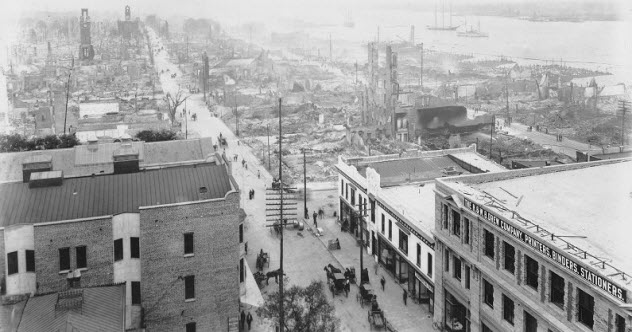
Besides the Midwest, Jacksonville, Florida, is the only place we can find the prairie-style architecture made famous by Frank Lloyd Wright. We have the third-largest urban fire in American history to thank for it.
On the afternoon of May 3, 1901, Jacksonville factory workers were relaxing on their lunch break when chimney sparks landed on a pile of drying Spanish moss, igniting the largest fire the Southeast had ever seen. Strong winds spread the fire from building to building through flaming roof shingles which flew through the hot, dry air.
Firefighters used numerous techniques to try to slow the advance of the blaze, from blowing up stretches of buildings to creating firebreaks to dousing buildings before the flames could reach them. But most of their efforts were ineffective, and over 700 acres and 146 city blocks were left in ruins. More than 2,300 buildings had been destroyed, and one-third of the 30,000 city residents were left homeless. It was reported that the smoke plume could be seen as far away as Raleigh, North Carolina.
After the flames died down, renowned New York City architect Henry John Klutho was enlisted to help rebuild the devastated city. At the time, Klutho was heavily influenced by the famous Frank Lloyd Wright and his prairie-style architecture, which can still be seen throughout much of Jacksonville today.
2 Great Fire Of Charleston
1838
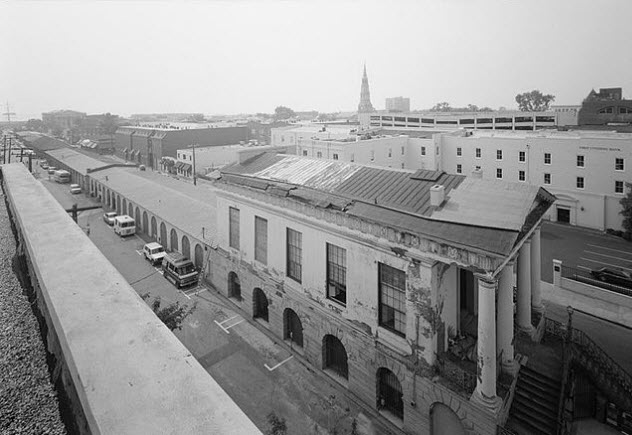
Charleston, South Carolina, is now known as a center of culture, arts, and architecture. Before 1838, however, Charleston was a city of mostly wooden and brick structures that were built to be affordable. Unknown to residents at the time, their city would soon be filled with Greek columns and Gothic Revival–style churches.
Little is known about the origins of the fire that swept Charleston in 1838 except that it started on the evening of April 27 and blazed until noon the next day. Over 1,000 buildings were damaged, and more than one-fourth of all the businesses within the city suffered damage, with losses of over $3 million.
Architects and city planners saw the destruction as a chance to rebuild the city better than before. Many municipal and business district buildings were constructed in the Greek Revival style with an enormous number of columns and facades. The religious community was also eager to take advantage of the chance to rebuild. Nearly every new church was built in the Gothic Revival style, giving many parts of Charleston a distinctly European flavor. This unique rebuilding has created a city known for its fierce preservation of architectural landmarks and cultural background.
1 First Great Fire Of New York
1776
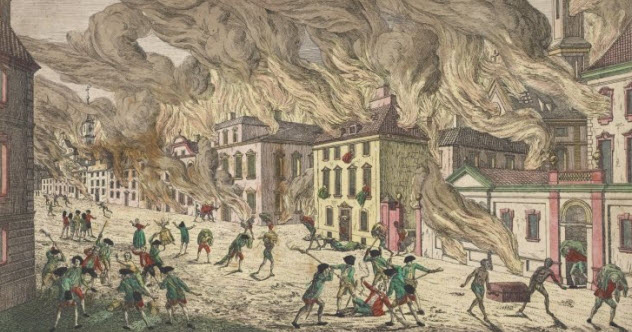
New York City’s first great fire occurred before the US had won independence from the British Empire. In fact, the first great fire is intertwined with the war between the Continental Army and the British forces.
In 1776, New York City was located on the lower island of Manhattan. That September, the British were moving toward the city, and General Washington decided that it would be too difficult to defend New York against the overwhelming enemy forces. The Continental Army withdrew on September 12, and the British arrived a few days later on September 15. Washington considered burning the city before the British could arrive, but the Continental Congress vetoed that idea.
Inexplicably, fire broke out anyway on the morning of September 21. The fire blazed most of the day and destroyed an estimated 1,000 buildings, nearly 25 percent of the city.
British commanders suspected the patriots of arson and arrested more than 200 residents. Although most were eventually released, some were hanged for treason. The British placed the city under martial law until their eventual evacuation in 1783. However, these conditions led to widespread crime and poor sanitation that caused persistent problems for the British during their occupation of the island.
General Washington later wrote of the fire: “Providence—or some good, honest fellow has done more for us than we were disposed to do for ourselves.”
Daniel is an entrepreneur, history buff, and fledgling writer. Any comments or contact is welcomed here!








